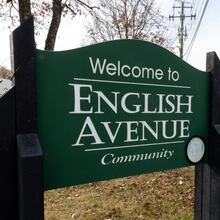Maybe it is not where you are, it’s whether you are stuck there.
Economically, that is: a number of experts say it may not be good that there is such a huge gap between poor and rich, but that’s not the whole story. Mobility matters: inequality isn’t so important if someone born near the bottom of the heap can power their way skyward with talent and hard work.
And where, you might ask, is Atlanta when it comes to that mobility?
In a talk here this week, a Stanford economist said he had crunched the numbers – millions of numbers from a number of sources — and concluded that when it came to getting ahead, Atlanta didn't rank so well.
Raj Chetty, who is also co-director of the National Bureau of Economic Research Program on Public Economics, spoke at the 13th annual Usery lecture sponsored by Georgia State University's Andrew Young School of Policy Studies and the Usery Workplace Research Group.
First, the United States is nowhere near the best at mobility, he said: The odds of a child born to parents in the bottom fifth of the income distribution reaching the top fifth is about 13.3 to 1 – a probability of 7.5 percent.
Ironically, some European countries outdo the United States, despite the stereotypes about the calcified European class system.
For instance, the probability of that happening in England is 9 percent. In Denmark, 11.7 percent. In Canada, it’s 13.5 percent.
But mobility inside the United States is anything but smooth, according to Chetty. It's pretty good in some places. Unfortunately, Atlanta lags the national average. (For statistics used by Chetty, click here.)
Chetty said that children who moved into more affluent areas when they were young do better – much better – as adults than the peers they left behind. On average, moving from poverty to non-poor areas makes someone 27 percent more likely to attend college, 30 percent less likely to become a single parent.
And the bottom line: it adds on average 30 percent to the earnings of that grown-up child.
Moving when you were older had little impact, he said.
The issue of inequality got a huge public boost several years ago thanks to the work of French economist, Thomas Piketty.
Mobility, like inequality, has been a political battleground with both left and right arguing that the policies they favor are the ones that work. And Chetty’s research will surely not end the debate, but he may be offering some support to both sides.
Chetty concludes that five factors line up with high mobility:
— Less segregation. Racial and income segregation are associated with less mobility, Chetty wrote.
— Less inequality. Places with a smaller middle class have much less mobility.
— More family structure. Areas with more single parents have much lower mobility. And mobility is better “even for kids whose own parents are married,” Chetty wrote.
— More community involvement.
— Higher school quality, something that seems to parallel more spending, smaller classes and higher test scores.
__________________________
Among a selected group of metro areas, the chances of a child born to the bottom fifth climbing to the top fifth:
— 12.9 percent in San Jose
— 11.0 percent in Washington, D.C.
— 10.8 percent in Salt Lake City
— 10.4 percent in Boston
— 8.7 percent in Denver
— 8.5 percent in Minneapolis
— 6.5 percent in Chicago
— 4.5 percent in Atlanta
— 4.4 percent in Charlotte
___________________________
In metro Atlanta, the chances of a child born to a family in the bottom fifth of incomes eventually reaching the top fifth:
— 14.3 percent in Forsyth County
— 6.7 percent in Cobb County
— 6.5 percent in Gwinnett County
— 5.0 percent in DeKalb County
— 1.9 percent in Fulton County
Source: Raj Chetty, Andrew Young School at Georgia State University
About the Author




